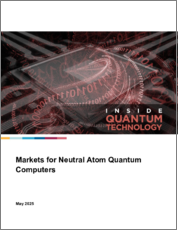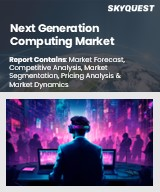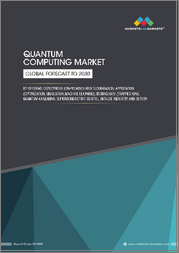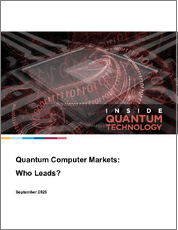
|
시장보고서
상품코드
1734969
중성 원자 양자 컴퓨터 시장Markets for Neutral Atom Quantum Computers |
||||||
중성 원자 양자 컴퓨터는 지배적인 초전도 양자 컴퓨팅 패러다임에 대한 도전인 동시에 더 진보된 기계로 가는 길을 제시하는 '주력' 양자 컴퓨터로 부상할 것으로 예상됩니다. 2025년에는 8대의 중성 원자 기계가 출하되지만, 2035년에는 7,310대 이상의 중성 원자 기계가 출하될 것으로 예상됩니다.
본 보고서 "중성 원자 양자 컴퓨터 시장"은 세계 주요 중성 원자 양자 컴퓨터 벤더들의 제품/시장 전략을 분석하였습니다. 여기에는 Atom Computing, Atom Quantum Labs, Infleqtion, M Squared, OpenQuantum, Pasqal, PlanQC, QuERA 등이 포함됩니다. 또한, 칩 및 부품 제조업체들이 중성자 기계에서 발견하고 있는 기회에 대해서도 자세히 살펴봅니다. 칩/컴포넌트 분야의 유명 기업으로는 AMD, Hamamatsu, NanoQT, Nu Quantum, QBlox, Toptica 등이 있습니다.
본 보고서에서는 중성 원자 양자 컴퓨터의 성공에 박차를 가하고 있는 주요 기술 동향을 분석합니다. 여기에는 크기, 무게, 전력 소비를 개선하기 위한 광집적회로(PIC)의 사용, 중성 원자 양자 컴퓨터를 최적으로 지원할 수 있는 새로운 재료 플랫폼, 중성 원자 양자 컴퓨터의 대규모 정부기관 및 연구시설에서의 사용에서 HPC 및 데이터센터로의 전환 등이 포함됩니다. 중성 원자 양자 컴퓨터에 있어 정말 중요한 것은 $/Qubit이 계속 매력적이어야 한다는 것입니다. 중성 원자 기술은 양자 산업계에서 점점 더 긍정적으로 전망되고 있습니다. 현재로서는 Amazon Bracket과 Azure Quantum이 중성 원자 양자 컴퓨터에 접근할 수 있는 유일한 일반적인 방법입니다.
목차
제1장 중성 원자 기술과 제품
- 테크놀러지의 진화
- 사용되는 원자
- 중성 원자에 대한 호의적인 시각이 증가하고 있다.
- 접근성
- 중성 원자 성분
- 원자 제어 하드웨어 및 판독 컴포넌트
- 광자 및 사진 컴포넌트
- 크라이오스탯
- 중성 원자 관련 소프트웨어
- 연구실에서의 작업
제2장 시장과 기원
- 대상 용도와 사용 가능성
- 중성 원자 컴퓨터별 분산 양자 컴퓨팅
- 데이터센터의 중성 원자 컴퓨터
- 중성 원자 컴퓨터의 기타 용도
- 제어와 생태계에 대해
- 중성 원자 컴퓨터 공급 구조
- 국가 문제
- 중성 원자 컴퓨터의 세계 시장과 국내 시장
- 관세 문제
제3장 중성 원자 기술
- 중성 원자 컴퓨터
- Atom Computing(미국)
- Atom Quantum Labs(슬로베니아)
- Infleqtion(미국)
- M Squared(영국)
- OpenQuantum(영국)
- Pasqal(프랑스)
- PlanQC(독일)
- QuEra Computing(미국)
- 중성 원자 구성요소와 서브시스템
- AMD(미국)
- Hamamatsu(일본)
- Lake Shore Cryotronics(미국)
- MenloSystems(독일)
- NanoQT(일본)
- Nexus Photonics(미국)
- Nu Quantum(영국)
- OpenQuantum(세계)
- Qblox(네덜란드)
- Quantum Machines(이스라엘)
- Sandia National Laboratories(미국)
- Toptica Photonics(독일)
- Vescent(미국)
- 소프트웨어
- 아 Agnostiq(캐나다)
- DarkStarStrix(사용자 이름)(미국)
- data cybernetics ssc GmbH(독일)
- Lawrence Berkeley National Laboratory(LBNL)(미국)
- M-Labs(홍콩)
- Microsoft(미국)
- Q-CTRL(호주)
- QMWare(스위스)
- QPerfect(프랑스)
- SimuQ(미국)
- Wolfram(미국)
- 플랫폼
- Amazon Braket(미국)
- qBraid(미국)
- Strangeworks(미국)
- 국내 및 국제 센터
- Department of Science and Technology(DOST)
- European Center for Quantum Sciences(CESQ)(프랑스)
- Japan Science and Technology Agency(일본)
- National Quantum Computing Centre(NQCC)(영국)
- Russian Quantum Center(러시아)
제4장 중성 원자 컴퓨터 10년 예측
ksm 25.06.13IQT Research believes Neutral Atom Quantum Computers are emerging as "workhorse" quantum computers that are both a challenge to the dominant superconducting quantum computing paradigm and a path forward to even more advanced machines. IQT Research believes that in 2025, only eight neutral atom machines will be shipped but this number will grow to more than 7,310 neutral atom machines by 2035.
This report, "Markets for Neutral Atom Quantum Computers" analyzes the product/market strategies of the leading neutral atom quantum computer vendors worldwide. These include Atom Computing, Atom Quantum Labs, Infleqtion, M Squared, OpenQuantum, Pasqal, PlanQC, and QuERA. But we also dig into the opportunities that the chip and component makers have been finding in neutral atom machines. Prominent firms in the chip/component segment include AMD, Hamamatsu, NanoQT, Nu Quantum, QBlox and Toptica.
This report also analyzes the key technological trends that are spurring the success of neutral atom quantum computers. These include the use of photonic integrated circuits (PICs) to improve size, weight, and power consumption; novel materials platforms that can best support neutral atom machines; and the transition of neutral atom machines from large government and research facilities usage to HPC and the data center. What really matters for neutral atom quantum computers is that $/Qubit continues to be attractive. IQT Research notes that neutral atom technology is portrayed increasingly positively in the quantum trade press. For now, Amazon Braket and Azure Quantum are the only public ways to access a neutral atom quantum computer.
Table of Contents
Chapter One: Neutral Atom Technology and Products
- 1.1. Evolution of Technology
- 1.1.1. Atoms Used
- 1.1.2. Neutral Atoms Viewed Increasingly Positively
- 1.1.3. Accessibility
- 1.2. Neutral Atom Components
- 1.2.1. Atomic Control Hardware and Readout Components
- 1.2.2. Photonic and Photographic Components
- 1.2.3. Cryostats
- 1.3. Neutral Atom-related Software
- 1.3.1. Work in Research Labs
Chapter Two: Markets and Origins
- 2.1. Target Applications and Possible Uses
- 2.1.1. Distributed Quantum Computing on Neutral Atom Computers
- 2.1.2. Neutral Atom Computers in the Data Center
- 2.1.3. Other Uses for Neutral Atom Computers
- 2.2. Of Control and Ecosystems
- 2.3. Supply Structure for Neutral Atom Computers
- 2.4. National Questions
- 2.4.1. Worldwide and National Markets for Neutral Atom Computers
- 2.4.2. The Question of Tariffs
Chapter Three: Neutral Atom Technologies
- 3.1. Neutral Atom Computers
- 3.1.1. Atom Computing (United States)
- 3.1.2. Atom Quantum Labs (Slovenia)
- 3.1.3. Infleqtion (United States)
- 3.1.4. M Squared (United Kingdom)
- 3.1.5. OpenQuantum (United Kingdom)
- 3.1.6. Pasqal (France)
- 3.1.7. PlanQC (Germany)
- 3.1.8. QuEra Computing (United States)
- 3.2. Neutral Atom Components and Subsystems
- 3.2.1. AMD (United States)
- 3.2.2. Hamamatsu (Japan)
- 3.2.3. Lake Shore Cryotronics (United States)
- 3.2.4. MenloSystems (Germany)
- 3.2.5. NanoQT (Japan)
- 3.2.6. Nexus Photonics (United States)
- 3.2.7. Nu Quantum (United Kingdom)
- 3.2.8. OpenQuantum (Global)
- 3.2.9. Qblox (The Netherlands)
- 3.2.10. Quantum Machines (Israel)
- 3.2.11. Sandia National Laboratories (United States)
- 3.2.12. Toptica Photonics (Germany)
- 3.2.13. Vescent (United States)
- 3.3. Software
- 3.3.1. Agnostiq (Canada)
- 3.3.2. DarkStarStrix (username) (United States)
- 3.3.3. data cybernetics ssc GmbH (Germany)
- 3.3.4. Lawrence Berkeley National Laboratory (LBNL) (United States)
- 3.3.5. M-Labs (Hong Kong)
- 3.3.6. Microsoft (United States)
- 3.3.7. Q-CTRL (Australia)
- 3.3.8. QMWare (Switzerland)
- 3.3.9. QPerfect (France)
- 3.3.10. SimuQ (United States)
- 3.3.11. Wolfram (United States)
- 3.4. Platforms
- 3.4.1. Amazon Braket (United States)
- 3.4.2. qBraid (United States)
- 3.4.3. Strangeworks (United States)
- 3.5. National and International Centers
- 3.5.1. Department of Science and Technology (DOST) (Philippines)
- 3.5.2. European Center for Quantum Sciences (CESQ) (France)
- 3.5.3. Japan Science and Technology Agency (Japan)
- 3.5.4. National Quantum Computing Centre (NQCC) (United Kingdom)
- 3.5.5. Russian Quantum Center (Russia)
Chapter Four: Ten-year Forecasts of Neutral Atom Computer
- 4.1. Forecasting Thoughts
- 4.2. Forecasts, their Uses and Uncertainties
- About the Analyst
Exhibit
- Exhibit 4-1: Ten-year Forecasts of Neutral Atom Quantum Computers



















